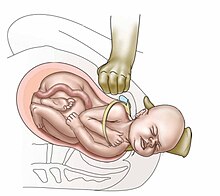
Back عسر ولادة الكتف Arabic Schulterdystokie German Distocia de hombros Spanish Dystocie des épaules French כליאת כתפיים HE Distocia di spalla Italian 肩甲難産 Japanese Schouderdystocie Dutch ସୋଲଡର ଡିସଟୋସିଆ OR Dystocja barkowa Polish
| Shoulder dystocia | |
|---|---|
 | |
| Suprapubic pressure being used in a shoulder dystocia | |
| Specialty | Obstetrics |
| Symptoms | Retraction of the baby's head back into the vagina[1] |
| Complications | Baby: Brachial plexus injury, clavicle fracture[2] Mother: Vaginal or perineal tears, postpartum bleeding[3] |
| Risk factors | Gestational diabetes, previous history of the condition, operative vaginal delivery, obesity in the mother, an overly large baby, epidural anesthesia[2] |
| Diagnostic method | The baby's shoulders fail to deliver despite gentle downward traction on the baby's head, requiring the need of special techniques to safely deliver the baby. |
| Treatment | McRoberts maneuver, suprapubic pressure, Rubin maneuver, episiotomy, all fours, Zavanelli's maneuver followed by cesarean section[3][2] |
| Frequency | 0.2% to 3% of vaginal births |
Shoulder dystocia occurs after vaginal delivery of the head, when the baby's anterior shoulder is obstructed by the mother's pubic bone.[3][1] It is typically diagnosed when the baby's shoulders fail to deliver despite gentle downward traction on the baby's head, requiring the need of special techniques to safely deliver the baby.[2] Retraction of the baby's head back into the vagina, known as "turtle sign" is suggestive of shoulder dystocia.[3][1] It is a type of obstructed labour.[4]
Although most instances of shoulder dystocia are relieved without complications to the baby, the most common complications may include brachial plexus injury, or clavicle fracture.[2][1] Complications for the mother may include increased risk of vaginal or perineal tears, postpartum bleeding, or uterine rupture.[3][1] Risk factors include gestational diabetes, previous history of the condition, operative vaginal delivery, obesity in the mother, an overly large baby, and epidural anesthesia.[2]
Shoulder dystocia is an obstetric emergency.[3] Initial efforts to release a shoulder typically include: with a woman on her back pushing the legs outward and upward, pushing on the abdomen above the pubic bone.[3] If these are not effective, efforts to manually rotate the baby's shoulders or placing the woman on all fours may be tried.[3][2] Shoulder dystocia occurs in approximately 0.2% to 3% of vaginal births.[5] Death as a result of shoulder dystocia is very uncommon.[1]
- ^ a b c d e f Gherman, Robert B.; Gonik, Bernard (2009). "Shoulder Dystocia". The Global Library of Women's Medicine. doi:10.3843/GLOWM.10137.
- ^ a b c d e f g Dahlke, JD; Bhalwal, A; Chauhan, SP (June 2017). "Obstetric Emergencies: Shoulder Dystocia and Postpartum Hemorrhage". Obstetrics and Gynecology Clinics of North America. 44 (2): 231–243. doi:10.1016/j.ogc.2017.02.003. PMID 28499533.
- ^ a b c d e f g h "Shoulder dystocia" (PDF). Royal College of Obstetricians and Gynaecologists. 2013. Retrieved 3 October 2018.
- ^ Buck, Carol J. (2016). 2017 ICD-10-CM Standard Edition - E-Book. Elsevier Health Sciences. p. 108. ISBN 9780323484572.
- ^ "Executive Summary: Neonatal Brachial Plexus Palsy". Obstetrics & Gynecology. 123 (4): 902–904. April 2014. doi:10.1097/01.AOG.0000445582.43112.9a. ISSN 0029-7844. PMID 24785634.